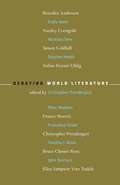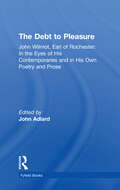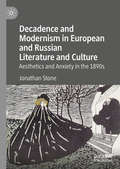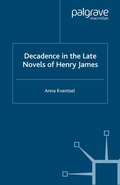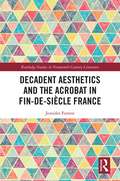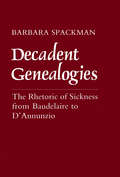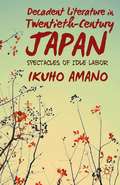- Table View
- List View
Debating World Literature (PDF)
by Peter Madsen Franco Moretti Christopher Prendergast Benedict Anderson Emily Apter Stanley Corngold Nicholas Dew Simon Goldhill Stephen Heath Stefan Hoesel-UhligIn the continuing debates about the cultural dimensions of globalization, the question of 'literature' has been something of a poor relation. This volume seeks to redress the balance. It takes as its starting point Goethe's idea of Weltliteratur, from which it then travels out to various parts of the globe at different historical junctures. Among its many concerns are the legacies of Goethe's idea, variable understandings of the term 'literature' itself, cross-cultural encounters, the nature of 'small literatures', and the cultural politics of literary genres. With contributions from many of the leading voices in the field, Debating World Literature seeks to transcend the pieties and simplifications of polemic in a search for the complexity embodied in the linking of the two terms 'world' and 'literature'.
Deborah Kerr (Film Stars)
by Sarah StreetThis illuminating study provides a comprehensive reassessment of Deborah Kerr's career, highlighting lesser-known aspects of her star persona. Sarah Street traces the specific qualities of Kerr's screen performances, paying close attention to facial expression, gesture, voice and costume. Covering many iconic films, including The Life and Death of Colonel Blimp, Black Narcissus, From Here to Eternity, An Affair to Remember, The Innocents and Bonjour Tristesse, this book follows Kerr’s journey from her foundational image as an 'English rose' to her performances of challenging roles in which she was cast 'against type'. Illustrated with images from Kerr’s films, this unique case study contributes to the critical understanding of film stars and screen performance. An ideal resource for undergraduate and postgraduate students of film and television studies, this fascinating guide will also appeal to film lovers and anyone interested in Kerr's complex career.
The Debt to Pleasure: John Wilmot, Earl of Rochester: In the Eyes of His Contemporaries and in His Own Poetry and Prose
by John WilmotRochester, incontestably the greatest of the Restoration poets and reprobates, is presented in The Debt to Pleasure both in his own words and in the words of those who loved and loathed him. The book is a mosaic in which the poet's voice and the voice of his age sound with startling, ribald and riotous clarity.
The Debt to Pleasure: John Wilmot, Earl of Rochester: In the Eyes of His Contemporaries and in His Own Poetry and Prose
by John WilmotRochester, incontestably the greatest of the Restoration poets and reprobates, is presented in The Debt to Pleasure both in his own words and in the words of those who loved and loathed him. The book is a mosaic in which the poet's voice and the voice of his age sound with startling, ribald and riotous clarity.
Deburau: Pierrot, Mime, and Culture (Routledge Advances in Theatre & Performance Studies)
by Edward NyeThis volume analyses the nature of the mime art of Deburau and of the pantomime performances of the Théâtre des Funambules in Paris in the context of Romantic art, literature and socio-political thought. Deburau and the Théâtre des Funambules are characteristic of Romantic art in that they are closely associated with certain aspirations for social reform, even revolution. Deburau was an iconic figure for intellectuals such as George Sand who effectively considered him to be part of the ‘poète-maçon’ movement. Edward Nye examines this fascination as well as the myth which developed from it. With its unique framing in art, literature and politics, this book is a must read for undergraduates and postgraduates in theatre, literary studies, and the Romantic period.
Deburau: Pierrot, Mime, and Culture (Routledge Advances in Theatre & Performance Studies)
by Edward NyeThis volume analyses the nature of the mime art of Deburau and of the pantomime performances of the Théâtre des Funambules in Paris in the context of Romantic art, literature and socio-political thought. Deburau and the Théâtre des Funambules are characteristic of Romantic art in that they are closely associated with certain aspirations for social reform, even revolution. Deburau was an iconic figure for intellectuals such as George Sand who effectively considered him to be part of the ‘poète-maçon’ movement. Edward Nye examines this fascination as well as the myth which developed from it. With its unique framing in art, literature and politics, this book is a must read for undergraduates and postgraduates in theatre, literary studies, and the Romantic period.
Decadence and Modernism in European and Russian Literature and Culture: Aesthetics and Anxiety in the 1890s
by Jonathan StoneDecadence and Modernism in European and Russian Literature and Culture: Aesthetics and Anxiety in the 1890s rewrites the story of early modernist literature and culture by drawing out the tensions underlying its simultaneous engagement with Decadence and Symbolism, the unsustainable combination of this world and the other. With a broadly framed literary and cultural approach, Jonathan Stone examines a shift in perspective that explodes the notion of reality and showcases the uneasy relationship between the tangible and intangible aspects of the surrounding world. Modernism quenches a growing fascination with the ephemeral and that which cannot be seen while also doubling down on the significance of the material world and finding profound meaning in the physical and the corporeal. Decadence and Symbolism complement the broader historical trajectory of the fin de siècle by affirming the novelty of a modernist mindset and offering an alternative to the empirical and positivistic atmosphere of the nineteenth century. Stone seeks to recreate a significant historical and cultural moment in the development of modernity, a moment that embraces the concept of Decadence while repurposing its aesthetic and social import to help navigate the fundamental changes that accompanied the dawn of the twentieth century.
Decadence and Orientalism in England and Germany, 1880-1920: 'The Indispensable East' (Oxford English Monographs)
by Katharina Herold-ZankerDecadence and Orientalism in England and Germany, 1880-1920 examines the Orientalist portrayal of Middle Eastern cultures in Decadent Literatures in England and Germany at the turn of the century. This book argues that the role of Orientalism in literary Decadence uniquely exposes its paradoxical engagement with other cultures. In bringing together two fin-de-siècle European literatures, this comparative study makes a case for the transnational, if not imperial, nature of Decadence. The East emerges as an 'indispensable' mediator between various versions of European Decadence. The book examines the role of the East with specific reference to selected English and German authors: starting from Oscar Wilde's Victorian vision of Egypt and Arthur Symons's and Violet Fane's image of Constantinople, it moves to Paul Scheerbart's and Else Lasker-Schüler's Decadent Babylon and Assyria and concludes by turning to Stefan George's exclusion of the East from his poetic practice. The geographical reach of the East focuses on regions of the Eastern Mediterranean and Northern Africa. The cultural translation of specifically the Middle East into different European national contexts gains new—sometimes oppositional—meanings, avoiding a one-sided representation of both the East and the two national literatures that absorbed it. In arguing for a Decadent cosmopolitanism as a model of heterogeneous inclusivity that reaches beyond the binaries established by Edward Said's Orientalism, the present book brings twenty-first century theories of cosmopolitanism into dialogue with art history and literature to uncover striking synergies and interdependences between the different manifestations of Decadence in England and Germany.
Decadence, Degeneration, and the End: Studies in the European Fin de Siècle
by Marja Härmänmaa Christopher NissenArt and literature during the European fin-de-siècle period often manifested themes of degeneration and decay, both of bodies and civilizations, as well as illness, bizarre sexuality, and general morbidity. This collection explores these topics in relation to artists and writers as diverse as Oscar Wilde, August Strindberg, and Aubrey Beardsley.
Decadence in Literature and Intellectual Debate since 1945
by Diemo LandgrafBridging the gap between decadence as it is traditionally understood in literary and cultural studies and its relevance to current phenomena, this interdisciplinary collection examines literary texts and movies from Europe and the United States since 1945.
Decadence in the Age of Modernism (Hopkins Studies in Modernism)
by Kate Hext Alex MurrayDecadence in the Age of Modernism begins where the history of the decadent movement all too often ends: in 1895. It argues that the decadent principles and aesthetics of Oscar Wilde, Walter Pater, Algernon Swinburne, and others continued to exert a compelling legacy on the next generation of writers, from high modernists and late decadents to writers of the Harlem Renaissance. Writers associated with this decadent counterculture were consciously celebrated but more often blushingly denied, even as they exerted a compelling influence on the early twentieth century. Offering a multifaceted critical revision of how modernism evolved out of, and coexisted with, the decadent movement, the essays in this collection reveal how decadent principles infused twentieth-century prose, poetry, drama, and newspapers. In particular, this book demonstrates the potent impact of decadence on the evolution of queer identity and self-fashioning in the early twentieth century. In close readings of an eclectic range of works by Virginia Woolf, James Joyce, and D. H. Lawrence to Ronald Firbank, Bruce Nugent, and Carl Van Vechten, these essays grapple with a range of related issues, including individualism, the end of Empire, the politics of camp, experimentalism, and the critique of modernity. Contributors: Howard J. Booth, Joseph Bristow, Ellen Crowell, Nick Freeman, Ellis Hanson, Kate Hext, Kirsten MacLeod, Kristin Mahoney, Douglas Mao, Michèle Mendelssohn, Alex Murray, Sarah Parker, Vincent Sherry
Decadence in the Age of Modernism (Hopkins Studies in Modernism)
by Kate Hext Alex MurrayDecadence in the Age of Modernism begins where the history of the decadent movement all too often ends: in 1895. It argues that the decadent principles and aesthetics of Oscar Wilde, Walter Pater, Algernon Swinburne, and others continued to exert a compelling legacy on the next generation of writers, from high modernists and late decadents to writers of the Harlem Renaissance. Writers associated with this decadent counterculture were consciously celebrated but more often blushingly denied, even as they exerted a compelling influence on the early twentieth century. Offering a multifaceted critical revision of how modernism evolved out of, and coexisted with, the decadent movement, the essays in this collection reveal how decadent principles infused twentieth-century prose, poetry, drama, and newspapers. In particular, this book demonstrates the potent impact of decadence on the evolution of queer identity and self-fashioning in the early twentieth century. In close readings of an eclectic range of works by Virginia Woolf, James Joyce, and D. H. Lawrence to Ronald Firbank, Bruce Nugent, and Carl Van Vechten, these essays grapple with a range of related issues, including individualism, the end of Empire, the politics of camp, experimentalism, and the critique of modernity. Contributors: Howard J. Booth, Joseph Bristow, Ellen Crowell, Nick Freeman, Ellis Hanson, Kate Hext, Kirsten MacLeod, Kristin Mahoney, Douglas Mao, Michèle Mendelssohn, Alex Murray, Sarah Parker, Vincent Sherry
Decadence in the Late Novels of Henry James
by A. KventselLooking at the novels of James's major phase in the context of fin-de-siècle decadence, this book illuminates central issues in the James corpus and central aspects of a rich and fraught cultural moment. Through a close examination of the textures of the novels, Kventsel defines and explores their psycho-cultural field of meaning.
Decadence: A Very Short Introduction (Very Short Introductions)
by David WeirThe history of decadent culture runs from ancient Rome to nineteenth-century Paris, Victorian London, fin de siècle Vienna, Weimar Berlin, and beyond. The decline of Rome provides the pattern for both aesthetic and social decadence, a pattern that artists and writers in the nineteenth century imitated, emulated, parodied, and otherwise manipulated for aesthetic gain. What begins as the moral condemnation of modernity in mid-nineteenth century France on the part of decadent authors such as Charles Baudelaire ends up as the perverse celebration of the pessimism that accompanies imperial decline. This delight in decline informs the rich canon of decadence that runs from Joris-Karl Huysmans's À Rebours to Oscar Wilde's The Picture of Dorian Gray, Aubrey Beardsley's drawings, Gustav Klimt's paintings, and numerous other works. In this Very Short Introduction, David Weir explores the conflicting attitudes towards modernity present in decadent culture by examining the difference between aesthetic decadence--the excess of artifice--and social decadence, which involves excess in a variety of forms, whether perversely pleasurable or gratuitously cruel. Such contrariness between aesthetic and social decadence led some of its practitioners to substitute art for life and to stress the importance of taste over morality, a maneuver with far-reaching consequences, especially as decadence enters the realm of popular culture today. ABOUT THE SERIES: The Very Short Introductions series from Oxford University Press contains hundreds of titles in almost every subject area. These pocket-sized books are the perfect way to get ahead in a new subject quickly. Our expert authors combine facts, analysis, perspective, new ideas, and enthusiasm to make interesting and challenging topics highly readable.
Decadence: A Very Short Introduction (Very Short Introductions)
by David WeirThe history of decadent culture runs from ancient Rome to nineteenth-century Paris, Victorian London, fin de siècle Vienna, Weimar Berlin, and beyond. The decline of Rome provides the pattern for both aesthetic and social decadence, a pattern that artists and writers in the nineteenth century imitated, emulated, parodied, and otherwise manipulated for aesthetic gain. What begins as the moral condemnation of modernity in mid-nineteenth century France on the part of decadent authors such as Charles Baudelaire ends up as the perverse celebration of the pessimism that accompanies imperial decline. This delight in decline informs the rich canon of decadence that runs from Joris-Karl Huysmans's À Rebours to Oscar Wilde's The Picture of Dorian Gray, Aubrey Beardsley's drawings, Gustav Klimt's paintings, and numerous other works. In this Very Short Introduction, David Weir explores the conflicting attitudes towards modernity present in decadent culture by examining the difference between aesthetic decadence--the excess of artifice--and social decadence, which involves excess in a variety of forms, whether perversely pleasurable or gratuitously cruel. Such contrariness between aesthetic and social decadence led some of its practitioners to substitute art for life and to stress the importance of taste over morality, a maneuver with far-reaching consequences, especially as decadence enters the realm of popular culture today. ABOUT THE SERIES: The Very Short Introductions series from Oxford University Press contains hundreds of titles in almost every subject area. These pocket-sized books are the perfect way to get ahead in a new subject quickly. Our expert authors combine facts, analysis, perspective, new ideas, and enthusiasm to make interesting and challenging topics highly readable.
Decadent Aesthetics and the Acrobat in French Fin de siècle (Routledge Studies in Nineteenth Century Literature)
by Jennifer ForrestIn his discussion of clowns in nineteenth-century French painting from Jean-Léon Gérôme’s 1857 La Sortie du bal masqué to Georges Rouault, art historian Francis Haskell wondered why they are so sad. The myth of the sad clown as an allegory for the unappreciated artist found echoes in the work of literary counterparts like Charles Baudelaire and his "Vieux saltimbanque" who seeks in vain a responsive public. For some, the attraction of the acrobatic clown for the creative imagination may have been his ability to embody the plight of the artist: these artistes generally led an ambulatory and uncertain existence. Other artists and writers, however, particularly the Decadents, perceived in the circus acrobat – including the acrobatic clown – a conceptual and performative tool for liberating their points of view from the prison-house of aesthetic convention. If authors’ protagonists were themselves sometimes failures, their aesthetic innovations often produced exhilarating artistic triumphs. Among the works examined in this study are the circus posters of Jules Chéret, Thomas Couture’s Pierrot and Harlequin paintings, Honoré Daumier’s saltimbanque paintings, Edgar Degas’s Miss Lala au Cirque Fernando, Édouard Manet’s Un bar au Folies-Bergère, the pantomimes of the Hanlon-Lees troupe, and novels, short stories, and poems by Théodore de Banville, Edmond de Goncourt, J. K. Huysmans, Gustave Kahn, Jules Laforgue, Catulle Mendès, Octave Mirbeau, Jean Richepin, Edouard Rod, and Marcel Schwob.
Decadent Aesthetics and the Acrobat in French Fin de siècle (Routledge Studies in Nineteenth Century Literature)
by Jennifer ForrestIn his discussion of clowns in nineteenth-century French painting from Jean-Léon Gérôme’s 1857 La Sortie du bal masqué to Georges Rouault, art historian Francis Haskell wondered why they are so sad. The myth of the sad clown as an allegory for the unappreciated artist found echoes in the work of literary counterparts like Charles Baudelaire and his "Vieux saltimbanque" who seeks in vain a responsive public. For some, the attraction of the acrobatic clown for the creative imagination may have been his ability to embody the plight of the artist: these artistes generally led an ambulatory and uncertain existence. Other artists and writers, however, particularly the Decadents, perceived in the circus acrobat – including the acrobatic clown – a conceptual and performative tool for liberating their points of view from the prison-house of aesthetic convention. If authors’ protagonists were themselves sometimes failures, their aesthetic innovations often produced exhilarating artistic triumphs. Among the works examined in this study are the circus posters of Jules Chéret, Thomas Couture’s Pierrot and Harlequin paintings, Honoré Daumier’s saltimbanque paintings, Edgar Degas’s Miss Lala au Cirque Fernando, Édouard Manet’s Un bar au Folies-Bergère, the pantomimes of the Hanlon-Lees troupe, and novels, short stories, and poems by Théodore de Banville, Edmond de Goncourt, J. K. Huysmans, Gustave Kahn, Jules Laforgue, Catulle Mendès, Octave Mirbeau, Jean Richepin, Edouard Rod, and Marcel Schwob.
Decadent Catholicism and the Making of Modernism
by Martin LockerdTracing the movement of literary decadence from the writers of the fin de siècle - Oscar Wilde, Aubrey Beardsley, Ernest Dowson, and Lionel Johnson - to the modernist writers of the following generation, this book charts the legacy of decadent Catholicism in the fiction and poetry of British and Irish modernists. Linking the later writers with their literary predecessors, Martin Lockerd examines the shifts in representation of Catholic decadence in the works of W. B. Yeats through Ezra Pound to T.S. Eliot; the adoption and transformation of anti-Catholicism in Irish writers George Moore and James Joyce; the Catholic literary revival as portrayed in Evelyn Waugh's Brideshead Revisited; and the attraction to decadent Catholicism still felt by postmodernist writers D.B.C. Pierre and Alan Hollinghurst. Drawing on new archival research, this study revisits some of the central works of modernist literature and undermines existing myths of modernist newness and secularism to supplant them with a record of spiritual turmoil, metaphysical uncertainty, and a project of cultural subversion that paradoxically relied upon the institutional bulwark of European Christianity. Lockerd explores the aesthetic, sexual, and political implications of the relationship between decadent art and Catholicism as it found a new voice in the works of iconoclastic modernist writers.
Decadent Catholicism and the Making of Modernism
by Martin LockerdTracing the movement of literary decadence from the writers of the fin de siècle - Oscar Wilde, Aubrey Beardsley, Ernest Dowson, and Lionel Johnson - to the modernist writers of the following generation, this book charts the legacy of decadent Catholicism in the fiction and poetry of British and Irish modernists. Linking the later writers with their literary predecessors, Martin Lockerd examines the shifts in representation of Catholic decadence in the works of W. B. Yeats through Ezra Pound to T.S. Eliot; the adoption and transformation of anti-Catholicism in Irish writers George Moore and James Joyce; the Catholic literary revival as portrayed in Evelyn Waugh's Brideshead Revisited; and the attraction to decadent Catholicism still felt by postmodernist writers D.B.C. Pierre and Alan Hollinghurst. Drawing on new archival research, this study revisits some of the central works of modernist literature and undermines existing myths of modernist newness and secularism to supplant them with a record of spiritual turmoil, metaphysical uncertainty, and a project of cultural subversion that paradoxically relied upon the institutional bulwark of European Christianity. Lockerd explores the aesthetic, sexual, and political implications of the relationship between decadent art and Catholicism as it found a new voice in the works of iconoclastic modernist writers.
Decadent Conservatism: Aesthetics, Politics, and the Past
by Dr Alex MurrayBritish Decadent literature was a radical attack on conventional morality and middle-class taste, its insistence on the autonomy of art and its exploration of sexuality, dissipation, and depravity at odds with the literary and social establishment. Yet this counter-cultural narrative has obscured the often reactionary and elitist tendencies of Decadent writers and artists of the fin de siècle. Decadent Conservatism offers the first in-depth examination of the intersection of Decadence and conservatism, arguing that underpinning both was the desire to find alternatives to liberal modernity. Both Decadents and conservatives turned to the past to uncover values and models of social organisation that could offer stability in a chaotic world. From well-known figures such as Oscar Wilde and W.B. Yeats, through to the forgotten editors of short-lived periodicals, important female aesthetes such as Michael Field, and politicians such as Arthur Balfour, Decadent Conservatism challenges conventional understandings of the relationship between aesthetics, politics, and the past in late-Victorian Britain. Through a series of thematic chapters exploring the alternative communities created by little magazines, the politics of Individualism, investments in monarchy and religion, Folk Decadence, and jingoistic and nationalist responses to the Second Anglo-Boer war, this study offers a new, and much messier, picture of fin-de-siècle literary politics. It will be of interest to those working on Victorian literature and modernism, as well as social, political, and cultural history of the period 1880-1920.
Decadent Conservatism: Aesthetics, Politics, and the Past
by Dr Alex MurrayBritish Decadent literature was a radical attack on conventional morality and middle-class taste, its insistence on the autonomy of art and its exploration of sexuality, dissipation, and depravity at odds with the literary and social establishment. Yet this counter-cultural narrative has obscured the often reactionary and elitist tendencies of Decadent writers and artists of the fin de siècle. Decadent Conservatism offers the first in-depth examination of the intersection of Decadence and conservatism, arguing that underpinning both was the desire to find alternatives to liberal modernity. Both Decadents and conservatives turned to the past to uncover values and models of social organisation that could offer stability in a chaotic world. From well-known figures such as Oscar Wilde and W.B. Yeats, through to the forgotten editors of short-lived periodicals, important female aesthetes such as Michael Field, and politicians such as Arthur Balfour, Decadent Conservatism challenges conventional understandings of the relationship between aesthetics, politics, and the past in late-Victorian Britain. Through a series of thematic chapters exploring the alternative communities created by little magazines, the politics of Individualism, investments in monarchy and religion, Folk Decadence, and jingoistic and nationalist responses to the Second Anglo-Boer war, this study offers a new, and much messier, picture of fin-de-siècle literary politics. It will be of interest to those working on Victorian literature and modernism, as well as social, political, and cultural history of the period 1880-1920.
Decadent Genealogies: The Rhetoric of Sickness from Baudelaire to D'Annunzio
by Barbara SpackmanBarbara Spackman here examines the ways in which decadent writers adopted the language of physiological illness and alteration as a figure for psychic otherness. By means of an ideological and rhetorical analysis of scientific as well as literary texts, she shows how the rhetoric of sickness provided the male decadent writer with an alibi for the occupation and appropriation of the female body.
The Decadent Image: The Poetry of Wilde, Symons, and Dowson (Edinburgh Critical Studies in Victorian Culture (PDF))
by Kostas BoyiopoulosThis book enquires into the problem of venerating artificiality and the inaccessibility of beauty associated with it whilst engaging in the sensuous, immediate experience as it is advocated by Walter Pater. It examines for the first time together poems by three protagonists of the 1890s: Oscar Wilde, Arthur Symons, and Ernest Dowson. It sees their poems as sites where the self sensually collides with or is immersed in their artifice. This is understood through the shift from Aestheticism to Decadence, which is marked by a greater emphasis on heterodox erotic experience. This study examines Wilde’s early poetry and its role in triggering this shift. It shows how the idea of an erotic encounter with artifice reaches its apex in Symons, and how in Dowson it ripens into vexed non-encounters.
The Decadent Image: The Poetry of Wilde, Symons, and Dowson (Edinburgh Critical Studies in Victorian Culture (PDF))
by Kostas BoyiopoulosThis book enquires into the problem of venerating artificiality and the inaccessibility of beauty associated with it whilst engaging in the sensuous, immediate experience as it is advocated by Walter Pater. It examines for the first time together poems by three protagonists of the 1890s: Oscar Wilde, Arthur Symons, and Ernest Dowson. It sees their poems as sites where the self sensually collides with or is immersed in their artifice. This is understood through the shift from Aestheticism to Decadence, which is marked by a greater emphasis on heterodox erotic experience. This study examines Wilde’s early poetry and its role in triggering this shift. It shows how the idea of an erotic encounter with artifice reaches its apex in Symons, and how in Dowson it ripens into vexed non-encounters.
Decadent Literature in Twentieth-Century Japan: Spectacles Of Idle Labor
by I. AmanoDecadence is a concept that designates a given historical moment as a phase of decay and valorizes the past as an irretrievable golden age. This study offers an innovative examination of a century of Japanese fiction through the analytical prism of decadence.
